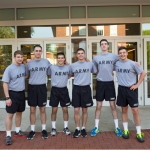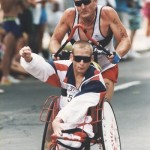SMARTherapy Athlete Motion Analysis Center
Why should I run?
Developing a consistent running program leads to the following benefits:
- Increased aerobic capacity, organ reserve, and skeletal mass
- Decreased musculoskeletal frailty
- Improved balance, response to vaccines, and higher order cognitive function
- Lower levels of circulating inflammatory markers
What are the most common risk factors for running injuries?
- Your experience with running programs impacts your risk of injury. If you have no prior running experience, you are 2-3 times more likely to sustain an injury
- Increasing weekly mileage too quickly can also be detrimental; once you start running over 40 miles per week you are 3 times more likely to be injured; those who run over 50 miles per week have a 70-75% annual injury rate
- Previous injuries can return upon starting a new running program. Do not ignore symptoms of an injury-the earlier you seek medical attention, you will likely be able to return to your program more quickly than if you were to run through the pain
Does my age impact my likelihood of injury?
- After the age of 40, the typical person will lose 5-8% of their muscle mass per decade
- If you are over 50 years old and run only 1 day per week, you are more likely to have an injury
- A study from 1984-2002 measured the frequency of osteoarthritis occurrences between a group of long distance runners and a matched control group. Two individuals in the control group underwent knee replacement surgery due to osteoarthritis over the course of the study, while no individuals within the running group necessitated this surgery.
- The most common age-related injuries are Achilles tendonitis and calf muscle symptoms (such as glut weakness and joint stiffness).
What are the most common running injuries, and what types of runners are affected by them?
- Marathon training accounts for up to 90% of running injuries, with the majority of runners experiencing foot injuries
- Sprinters most often report muscle strains and tendonitis, while mid-distance runners experience lumbar spine and hip pain
- 65% of runners will have an annual injury, though the more experience that you have as a runner, the less prone you will be to injuries
- The most common injuries sustained by runners are:
- Achilles tendinitis
- Achilles tendinopathy
- Plantar heel pain
- Medial tibial stress syndrome
- Patellofemoral pain syndrome
- IT band syndrome
Does the impact from running cause injury?
- It is not the impact itself that matters, but how your body handles the impact. Proper biomechanics and appropriate shoewear can adjust how your body will handle the impact caused by running.
- Osteoarthritis occurrence is equal between non-runners and runners.
- Running on hard surfaces vs soft surfaces does not affect the impact on your body
- The incidence of stress fractures is not dependent on the shock absorption of insoles
How do hills affect my running mechanics?
- Running uphill decreases stress and requires more energy. Each 1% incline requires 4% more energy
- Running downhill at a 9% grade increases load by 50%.
- When running on a treadmill, set the incline at 1% to mimic outdoor running and acclimate yourself to hill running.
How does my foot alignment impact my running?
- Pronation is a flattening of the arch, which causes your foot to roll in. This causes twisting of the ankle, knee, and hip, which can lead to stress fractures, shin splints, and other injuries. To evaluate if you pronate, check your running shoes-they will be worn out along the inside edges.
- Supination occurs when you have high arches that do not flatten. Your foot stays rigid and does not roll in as it is supposed to, causing less shock absorption. This can result in ankle sprains, Achilles tendonitis, plantar fasciitis, and IT band syndrome. To check if you supinate, check your running shoes-they will be worn out along the outside edges.
- Having a neutral foot allows for good shock absorption, proper flatting (pronation) of your arch, and increased push off power.
How does my stride affect my performance?
- Heel-striking places impact in front of you, causing a braking effect; consequently, you will either move at a slower speed, or exert more energy to maintain your speed. In addition, increased load is transferred to the ankle, knee, and hip.
- Longer strides can lead to increased vertical displacement, which requires you to exert more energy. Running a marathon with increased vertical displacement can lead you to exert energy equal to running an extra 7 miles.
- Barefoot running encourages you to get on your toes and increase your stride rate, while decreasing your stride length.
What type of shoes should I wear?
- Efficient runners, supinators, and those with a rigid foot should wear a neutral/cushioned running shoe
- Mid-weight runners and pronators should wear a stability shoe
- Motion control shoes are not good for runners as they do not allow for proper movement of the foot
- Your running shoe should be ½ inch longer than the longest digit with a snug heel cup
- You should change shoes every 300-400 miles. Around 200-300 miles, get a new pair and begin putting the new shoe into rotation for the last 100 miles as the change in the shoe will alter your running mechanics.
- Speak with your doctor or physical therapist to see if orthotics would help with your alignment.
How can I avoid injury?
- Incorporate cross training exercises into your workout routine
- Run slower
- Change shoes often
- Maintain flexibility
- Maintain range of motion
- Improve quad/glut/hamstring/calf strength
- Run 40 miles or less per week
I am a beginner runner-what tips do you have?
- Look forward and keep your body relaxed
- Keep your shoulders relaxed and loose; do not let them come up into your ears
- Keep your trunk tall; driving your elbows behind you and pinching your shoulder blades together will help this
- Keep your hips in line with your trunk
- Drive your legs and ankles forward and upwards; push off with your toes
- Keep your arms close to your body; focus on driving your elbows backwards rather than forwards
- Do not clench your hands; hold them as if you are holding a potato chip in your fingers
- Exhale fully; keep your muscles relaxed so you can take complete breaths
- When running uphill, shorten your stride and drop your arms
- When running downhill, stay in control and lengthen your stride slightly
Area running groups
- Virginia: Arlington Road Runners, Northern Virginia Running Club
- Maryland: Montgomery County Road Runners, Prince George Running Club
- Washington, D.C.: DC Road Runners, DC Running Club, Washington Running Club, Capital Striders, Front Runners
Need a little inspiration?
 Team Reviresco ROTC Cadets from University of Delaware ran 1678 miles from Newark, Delaware to Houston, Texas. They aim to bridge the gap between civilian and military relations by educating and empowering society to understand their role in helping provide financial, spiritual and moral support for all veterans.
Team Reviresco ROTC Cadets from University of Delaware ran 1678 miles from Newark, Delaware to Houston, Texas. They aim to bridge the gap between civilian and military relations by educating and empowering society to understand their role in helping provide financial, spiritual and moral support for all veterans. Kayla Montgomery, 18 years old, suffers from Multiple Sclerosis. She began as one of the slowest runners on her team but has trained her way to becoming one of the fastest distance runners in the nation-yet Kayla is unable to feel her legs while she runs. As she finishes she collapses into her coaches arms as she cannot stand on her legs.
Kayla Montgomery, 18 years old, suffers from Multiple Sclerosis. She began as one of the slowest runners on her team but has trained her way to becoming one of the fastest distance runners in the nation-yet Kayla is unable to feel her legs while she runs. As she finishes she collapses into her coaches arms as she cannot stand on her legs. Team Hoyt is a father/son team who began competing in 1977. Dick (the father) pushed Rick in his wheelchair for a 5 mile race and came in next to last. They have now completed over 1,000 races, including marathons, duathlons and triathlons (6 of them being Ironman competitions). Also adding to their list of achievements, Dick and Rick biked and ran across the U.S. in 1992, completing a full 3,735 miles in 45 days.
Team Hoyt is a father/son team who began competing in 1977. Dick (the father) pushed Rick in his wheelchair for a 5 mile race and came in next to last. They have now completed over 1,000 races, including marathons, duathlons and triathlons (6 of them being Ironman competitions). Also adding to their list of achievements, Dick and Rick biked and ran across the U.S. in 1992, completing a full 3,735 miles in 45 days.
If you have an injury or experience pain when running see your primary care physician or orthopaedic doctor and get the care you need to allow for a long and rewarding running career!!
